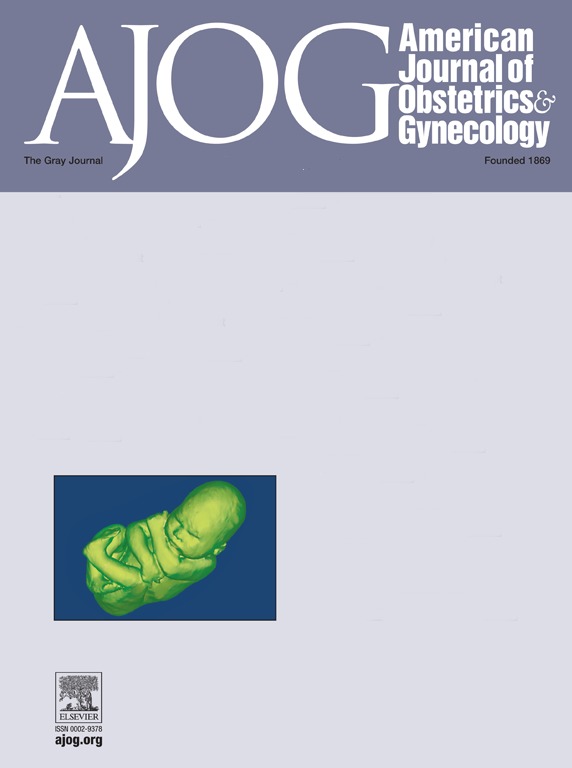Prognostic role of immunohistochemical and molecular markers in no specific molecular profile endometrial cancer: a systematic review and meta-analysis.
IF 8.4
1区 医学
Q1 OBSTETRICS & GYNECOLOGY
引用次数: 0
Abstract
OBJECTIVE No specific molecular profile (NSMP) endometrial cancer represents nearly half of the diagnoses, characterized by significant molecular heterogeneity and intermediate recurrence and survival outcomes. Currently, no immunohistochemical or molecular markers are established in guidelines to improve prognosis estimation and personalize treatment in NSMP endometrial cancer. This systematic review and meta-analysis aimed to evaluate the prognostic significance of potential immunohistochemical and molecular surrogate markers in NSMP endometrial cancers. DATA SOURCES This systematic review and meta-analysis adhered to PRISMA guidelines and was registered with PROSPERO (CRD42024601035). A comprehensive literature search was conducted using Scopus, PubMed/MEDLINE, ScienceDirect, and the Cochrane Library (January 1994-December 2024). STUDY ELIGIBILITY CRITERIA Studies assessing the prognostic roles of L1CAM, CTNNB1, ARID1A, estrogen receptor (ER), progesterone receptor (PR), and STATHMIN expression or mutation status in NSMP endometrial cancers were included. STUDY APPRAISAL AND SYNTHESIS METHODS Methodological quality was assessed using the Newcastle-Ottawa Scale (NOS) and the Quality in Prognosis Studies (QUIPS) tool for risk of bias in prognostic studies. Certainty of evidence for each outcome was evaluated using the Grading of Recommendations, Assessment, Development and Evaluation (GRADE) approach. Hazard ratios (HR) for recurrence and survival were calculated using random- or fixed-effects models depending on heterogeneity. RESULTS Fourteen retrospective studies including 4,654 NSMP endometrial cancers were analysed. L1CAM overexpression significantly predicted higher recurrence (HR=3.42, 95% CI:1.86-6.29; p<0.001) and worse survival (HR=4.31, 95% CI:2.62-7.09; p<0.001). ER positivity correlated significantly with reduced recurrence risk (HR=0.37, 95% CI:0.26-0.53) and improved survival (HR=0.22, 95% CI:0.17-0.29). Loss of PR expression was associated with increased recurrence and poorer survival outcomes. Conversely, ARID1A and CTNNB1 mutations and STATHMIN1 overexpression did not significantly impact recurrence or survival outcomes. CONCLUSIONS L1CAM overexpression, ER positivity, and PR status demonstrate significant prognostic relevance in NSMP endometrial cancer, warranting consideration as potential markers for improving patient management, including fertility-sparing approach.免疫组织化学和分子标记在无特异性分子谱的子宫内膜癌中的预后作用:系统回顾和荟萃分析。
目的:非特异性分子谱(NSMP)子宫内膜癌占诊断的近一半,其特征是显著的分子异质性和中等的复发和生存结果。目前,在指南中还没有建立免疫组织化学或分子标记物来改善NSMP子宫内膜癌的预后评估和个性化治疗。本系统综述和荟萃分析旨在评估潜在的免疫组织化学和分子替代标志物在NSMP子宫内膜癌中的预后意义。该系统评价和荟萃分析遵循PRISMA指南,并在PROSPERO注册(CRD42024601035)。使用Scopus、PubMed/MEDLINE、ScienceDirect和Cochrane Library(1994年1月- 2024年12月)进行了全面的文献检索。研究资格标准:包括评估L1CAM、CTNNB1、ARID1A、雌激素受体(ER)、孕激素受体(PR)和STATHMIN表达或突变状态在NSMP子宫内膜癌中的预后作用的研究。研究评价和综合方法采用纽卡斯尔-渥太华量表(NOS)和预后研究质量(QUIPS)工具评估预后研究的偏倚风险。采用推荐、评估、发展和评价分级(GRADE)方法评估每个结果的证据确定性。根据异质性,使用随机或固定效应模型计算复发和生存的风险比(HR)。结果对包括4654例NSMP子宫内膜癌的14项回顾性研究进行了分析。L1CAM过表达可显著预测较高的复发率(HR=3.42, 95% CI:1.86 ~ 6.29, p<0.001)和较差的生存率(HR=4.31, 95% CI:2.62 ~ 7.09, p<0.001)。ER阳性与降低复发风险(HR=0.37, 95% CI:0.26-0.53)和提高生存率(HR=0.22, 95% CI:0.17-0.29)显著相关。PR表达的缺失与复发率的增加和较差的生存结果相关。相反,ARID1A和CTNNB1突变和STATHMIN1过表达对复发或生存结果没有显著影响。结论sl1cam过表达、ER阳性和PR状态在NSMP子宫内膜癌中具有显著的预后相关性,值得考虑作为改善患者管理的潜在标志,包括保留生育方法。
本文章由计算机程序翻译,如有差异,请以英文原文为准。
求助全文
约1分钟内获得全文
求助全文
来源期刊
CiteScore
15.90
自引率
7.10%
发文量
2237
审稿时长
47 days
期刊介绍:
The American Journal of Obstetrics and Gynecology, known as "The Gray Journal," covers the entire spectrum of Obstetrics and Gynecology. It aims to publish original research (clinical and translational), reviews, opinions, video clips, podcasts, and interviews that contribute to understanding health and disease and have the potential to impact the practice of women's healthcare.
Focus Areas:
Diagnosis, Treatment, Prediction, and Prevention: The journal focuses on research related to the diagnosis, treatment, prediction, and prevention of obstetrical and gynecological disorders.
Biology of Reproduction: AJOG publishes work on the biology of reproduction, including studies on reproductive physiology and mechanisms of obstetrical and gynecological diseases.
Content Types:
Original Research: Clinical and translational research articles.
Reviews: Comprehensive reviews providing insights into various aspects of obstetrics and gynecology.
Opinions: Perspectives and opinions on important topics in the field.
Multimedia Content: Video clips, podcasts, and interviews.
Peer Review Process:
All submissions undergo a rigorous peer review process to ensure quality and relevance to the field of obstetrics and gynecology.

 求助内容:
求助内容: 应助结果提醒方式:
应助结果提醒方式:


